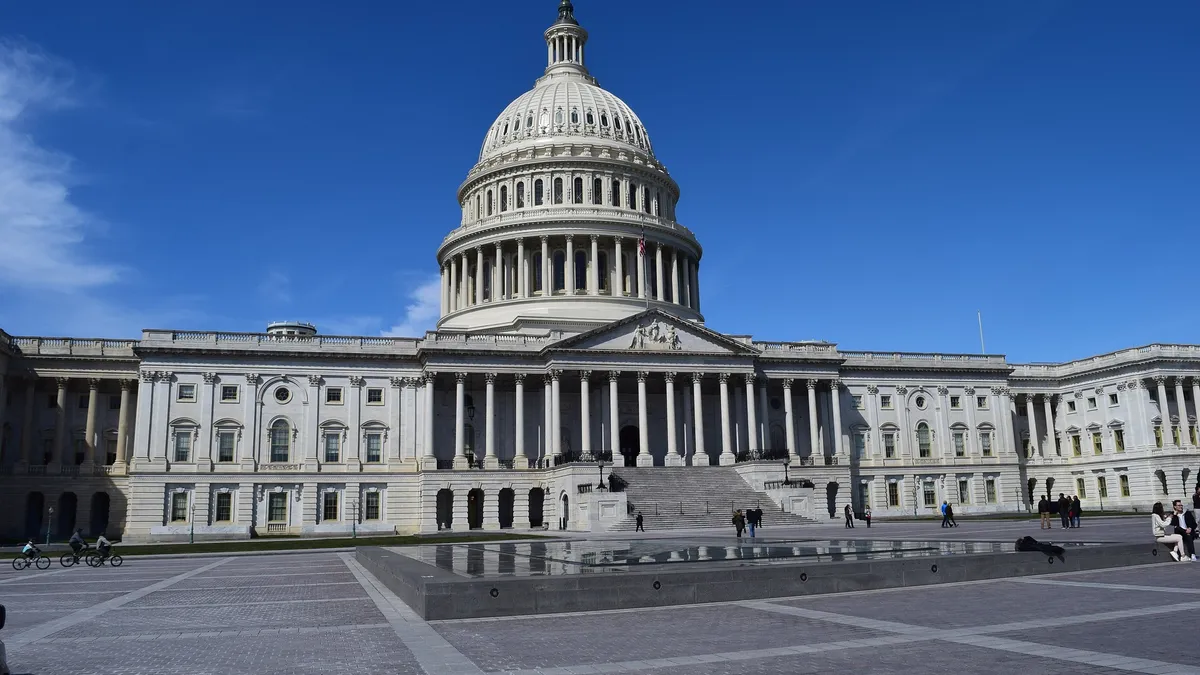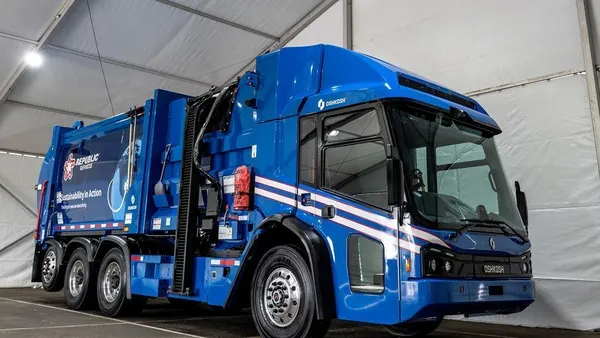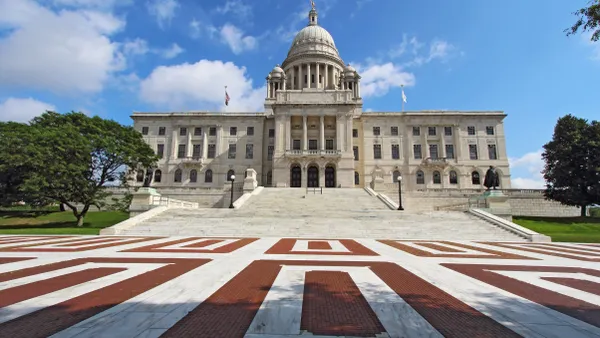A new bill in Congress, meant to achieve net zero greenhouse gas emissions by 2050, names numerous waste and recycling efforts to help reach that goal, including some strategies outlined in other bills expected to make a comeback this year.
The Climate Leadership and Environmental Action for our Nation’s (CLEAN) Future Act, introduced by Rep. Frank Pallone (D-N.J.), includes measures such as establishing post-consumer recycled content standards for certain products, standardizing recycling labels and creating multiple grant programs.
The bill incorporates or overlaps with elements of other notable federal recycling-related bills introduced in recent years, including the Break Free From Plastic Pollution Act introduced last year and the Zero Waste Act of 2019. Industry stakeholders see this as a sign that lawmakers are using multiple avenues to further recycling and waste reduction efforts as national attention on the issues increase.
It also draws on other energy, economic, infrastructure and job-related strategies. Waste and recycling initiatives are just one piece of the wide-ranging bill, but sponsors say they play a role in the effort to achieve net zero greenhouse gas emissions by 2050 and an interim 2030 goal of bringing those emissions down 50% from 2005 levels.
Pallone, chair of the House Energy and Commerce Committee, introduced the bill March 2 along with Environment and Climate Change Subcommittee Chairman Paul Tonko (D-N.Y.) and Energy Subcommittee Chairman Bobby Rush (D- Ill.). The sponsors said the bill aims to make substantive steps toward addressing climate change while creating jobs.
“We will not watch from the sidelines as the climate crisis wreaks havoc on Americans’ health and homes,” Pallone said in a statement announcing the bill.
Recycling and waste initiatives outlined in the bill include a plan to establish post-consumer recycled content standards for beverage containers and some other products, as well as implement a national bottle deposit program. It would also create a task force meant to establish an extended producer responsibility (EPR) system for certain products and would ask manufacturers to standardize labeling on some products to more accurately and clearly indicate their recyclability.
The plan directs the EPA to develop several grants, including $150 million for zero waste initiatives and $250 million for landfill diversion. It would also allocate $15 million for recycling and waste reduction education grants and $100 million for composting or anaerobic digestion projects. It also asks the EPA to standardize the labeling on recycling receptacles.
It would further direct the National Academy of Sciences to conduct a study on single-use products and product bans to determine any environmental, economic, or other effects of such bans.
The bill additionally seeks to place a “temporary pause” on permitting for new and expanded plastic production facilities so the EPA can update clean air regulations related to the facilities. Permits for any new or expanded plastic production facilities would have to address environmental justice impacts through assessments and meetings with affected communities.
The bill also addresses several aspects of environmental justice through provisions like authorizing grants for fenceline communities to participate in the regulation and monitoring of solid waste disposal sites, and requiring environmental justice impacts be considered when states create hazardous waste disposal plans.
Stakeholders say the inclusion of zero waste and recycling initiatives in the bill is a positive step toward achieving climate change goals, but have mixed feelings on certain provisions.
Environmental groups such as U.S. PIRG and the Natural Resources Defense Council have praised the bill in general terms, saying the country urgently needs comprehensive strategies to battle climate change, but some stakeholders are waiting to see how bill language evolves in committee hearings before commenting on specific provisions, said Alex Truelove, zero waste director at U.S. PIRG. He anticipates some segments of the bill will likely be fleshed out with more specific language, including the section calling for an EPR task force.
David Biderman, executive director of the Solid Waste Association of North America (SWANA), sees the bill language as being in early stages and anticipates providing further feedback “and collaborating with other stakeholders to improve the legislation,” he said.
Though representatives from SWANA, the National Waste & Recycling Association and the Institute of Scrap Recycling Industries say they are still reading through the bill as written, they anticipate potentially getting on board with the bill’s call for the EPA to fund grants for recycling education efforts – a topic the trade groups have supported in past bills such as the RECYCLE Act.
The trade groups also said they tentatively support the CLEAN Future Act’s mentions of post-consumer content standards for beverage containers, saying it could help spur demand for certain recycled materials and encourage more recycling for some packaging types.
NWRA also supports the bill’s product labeling requirements, which aim to more clearly mark which products and packaging are recyclable. Anne Germain, NWRA’s chief operating officer and vice president of technical and regulatory affairs, said confusing labeling can lead to contamination in recycling. “Clear, unambiguous labeling that is undergirded by what is actually recyclable will help with recycling,” she said in an email.
Other elements of the CLEAN Future Act have drawn criticism, including the section calling for a a temporary pause on new permits for facilities that produce plastics, or the raw materials used to produce plastics, such as ethylene and propylene.
Plastics Industry Association President and CEO Tony Radoszewski said the bill unfairly targets plastic and plastic recycling innovations. “Addressing climate change is a laudable goal, but the CLEAN Future Act—as currently introduced—aims to end the manufacture of one of our country’s most valuable and sustainable materials: plastics,” he said in a statement.
Radoszewski specifically mentioned the toll the bill could take on advanced recycling, the process of breaking plastics down to the molecular level using heat or another catalyst in order to use the “building blocks” to create new products. The CLEAN Future Act also would also pause permitting for facilities that “repolymerize plastics into chemical feedstocks.”
Environmental groups, recyclers and the plastics industry are currently battling over advanced recycling’s place in the circular economy in several states, including Virginia.
Others criticize the bill’s proposal to create a national bottle bill program, which it says will be modeled after unnamed state bottle bill programs. Jim Riley, NWRA’s general counsel and senior vice president of government affairs, said a national bottle bill could disrupt recycling markets, recycling facilities and taxpayers by removing about half of plastics and aluminum from curbside recycling streams. That could increase curbside recycling costs and reduce revenue for municipal recyclers, he said.
Industry and environmental groups say they don’t expect the CLEAN Future Act to replace other relevant recycling bills that could also address some of their priorities. Bill sponsors anticipate the Break Free From Plastic Pollution Act to return in mid-March. A spokesperson from the office of Rep. Ilhan Omar (D-Minn.), sponsor of the Zero Waste Act, said she will also reintroduce her bill sometime later this year.
The overlapping bills could act as a “backstop” that gives recycling and waste reduction efforts multiple chances to make it through the legislative session, Truelove said. Experts already anticipate that other recycling bills may not be signed into law this year because of low bandwidth due to COVID-19 relief discussions. The CLEAN Future Act weighs in at 981 pages and covers numerous climate change strategies that will need to be discussed in multiple committees, which could make it hard to move through Congress before the legislative session is over, he said.














